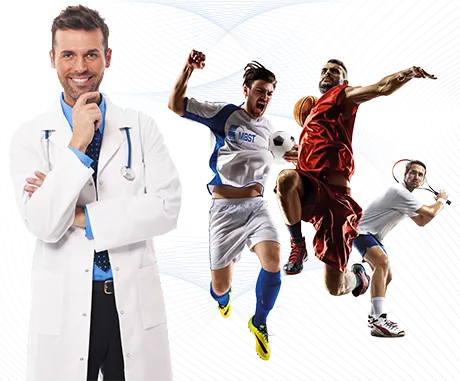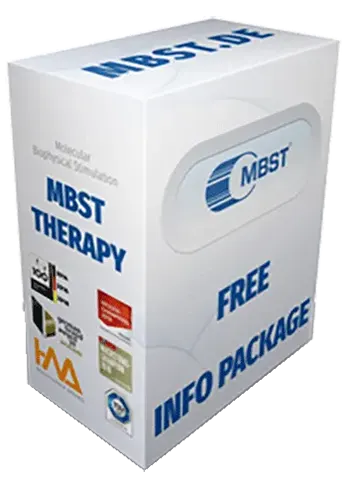
Guide sports injuries · Return to play
Sport has lots of positive effects on health. It can contribute significantly to improving and stabilising the physical capability in every age. But with recreational sports gaining on popularity as well as always increasing demands in competitive sports, the number and severity of sports injuries is constantly on the rise.
In many cases, the consequences not only affect the sports activity but also the professional and private everyday life.
Information about sports and accidental injuries
What can be done in cases of injuries of muscles, ligaments and tendons?

Sports injuries · What are these?
A sports injury is a trauma which an athlete suffers during training or competition. Most common are injuries to muscles, ligaments and tendons, sprains, strains, bruises and fractures. If muscles, ligaments and tendons get injured, they lose their functionality, which can limit almost any physical activity and resilience. Therefore, the correct treatment and a fast but above all sustainable recovery are important parts of the regenerative phase.
Sports injuries · Long-term consequences
Small injuries are often underestimated. The affected body parts are often stressed too soon and too hard as soon as the first symptoms subside. In this way, chronic symptoms can develop which result in long downtimes in training or competitions. Chronic injuries that formed this way do not only restrict sports activities but also have a heavy impact on the quality of life. In the case of professional athletes, the entire career can be in danger.
Common sports injuries
Muscles · Musculus
A skeletal muscle consists of muscle fascicles and the surrounding fascias (connective tissue). Close to the bone, the fascias on the head of the muscle join together to form the tendons. Depending on extent and severity of a muscle injury, the affected person may not be able to do sports or go to work for several months.
Grades of muscle injuries
Muscles can get damaged by overstressing or by external impacts. Muscle strains or indurations are classfied as functional microlesions. Severe damage such as torn muscle fibres are classfied as structural macrolesions. They are distinguished by the severity of the muscle injury.
Stage 1 + 2 · < 5% of muscle fibres
Rupture of Individual muscle fibres, intact fascias + haematoma with slight loss of strength
Stage 3 · > 5% of muscle fibres
Rupture of many muscle fibres, partially ruptured fascias + internal bleeding with clear loss of ability to contract
Stage 4 · > 5% of muscle fibres
Complete rupture of muscle and fascias with complete loss of functionality
Tendons · Tendo
Tendons are the connections between muscles and bones. They consist of a nearly non-elastic, high-fibre connective tissue with a slow metabolism. This is why the regeneration process takes a long time when microruptures occur due to incorrect stress distribution or overstressing. Results are pain at pressure and movement as well as a restricted limb functionality.
Ligaments · Ligament
Ligaments connect bones and help to stabilise the joints. They are similar to tendons and therefore only have a limited regenerative capacity. In many cases, they do not heal completely once damaged.
Injuries to tendons and ligaments
These often occur when a joint is stressed too much or in the wrong way. In most cases, there had already been previous damage, repeated microtrauma which lead to the degeneration of the structure of ligament and tendon. More stress may cause the tendon or ligament to rupture which inevitably requires surgical treatment.
MBST in the treatment of sports and accidental injuries
Molecular biological wound healing processes are complex and take a long time. Put simply, they are described as follows:
Destructive phase · inflammatory cell reactions
Vascular phase: day 0–2 / cellular phase: day 2–5
Proliferative phase
Repair phase: day 5–21
Remodulating phase · recovery phase
Consolidating phase: day 21–60 / Organisation or maturing phase: day 60–360
It can take months until a muscle, tendon or ligament injury is healed completely because the repair and regeneration processes take a long time due to the slow metabolism of the damaged tissue.
Molecular biophysical stimulation
This is the starting point for MBST therapy. Its objective is to increase the metabolism and thereby re-trigger the body’s own repair mechanisms and regeneration processes by a targeted energy transfer into the damaged tissue.
MBST therapy is based on the physical principle of magnetic resonance, in which hydrogen nuclei take up energy and then release it again partly into the surrounding tissue. Scientific data suggests that MBST magnetic resonance technology stimulates various biophysical processes and triggers anti-inflammatory and pain-relieving effects.[1,2,3] Damaged cells shall be influenced in such a way that natural regenerative processes can be triggered. The treated tissue shall regain as much functionality as possible.
The therapy approach of relieving the symptoms as well as stimulating the body’s own healing processes is a crucial factor for the fast and long-term success of the MBST therapy in the treatment of sports injuries. MBST therapy is an optimal supplement to postsurgical and post-inpatient treatment. By accelerating biological healing processes MBST magnetic resonance therapy can reduce the necessary downtimes in professional and leisure sports without medication or illegal substances. The aim is to enable a fast but also safe return to training, competition and work.
MBST therapy in professional sports
Top athletes, who have been treated with MBST therapy, report that they could resume their training earlier than prognosticated and were even able to win medals for instance in Olympic Games and World Championships shortly after injuries. This is why MBST therapy is now an integral part of the treatment range of several team and sports doctors.
Other indications
MBST magnetic resonance therapy is used in the treatment of different acute and chronic injuries of muscles, ligaments and tendons. MBST is also applicated in cases of damages to bones such as fractures, for long-term effects of injuries such as osteoarthritis or pseudarthrosis or for damages caused by overstressing like the so called tennis elbow. Please consult a doctor in an MBST treatment centre to find out if your complaints can be treated as well with MBST magnetic resonance therapy.
The advantages of MBST magnetic resonance therapy in cases of osteoarthritis at a glance:
[1] Temiz Artmann et al. 2011, Methods and Findings in Experimental and Clinical Pharmacology, 27(6), 391–394 · [2] Melzer et al. 2003, Fachkrankenhaus für Orthopädie · [3] Steinecker-Frohnwieser et al. 2014, J Orthopedics Rheumatology, 9/2014 · [4] Kullich/Melzer 2018, Scientific evaluation of the MBST Magnetic Resonance Technology regarding the therapeutic potential and proof of clinical efficacy


MBST therapy for sports injuries · Overview